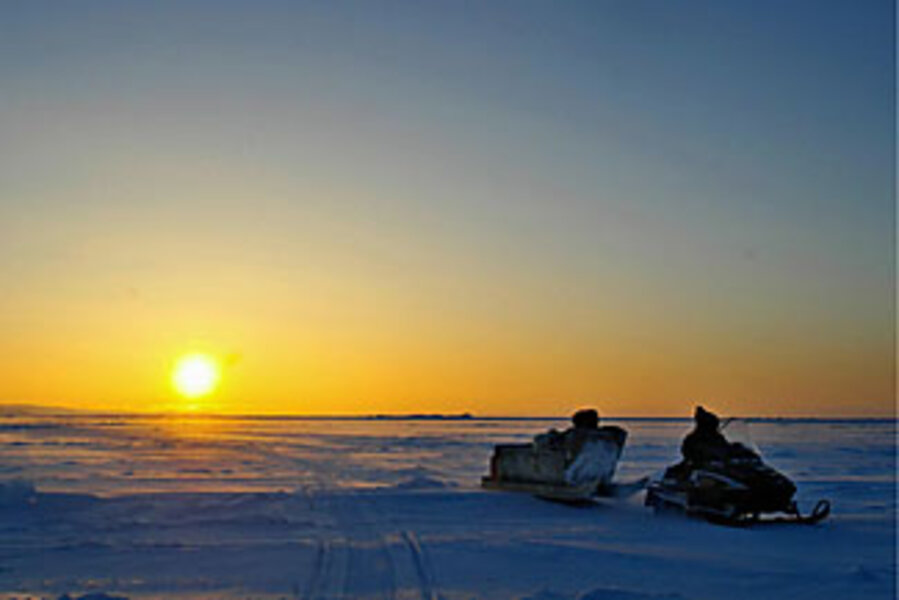Inuit sled dog controversy brings troubled past to light
Loading...
| Ottawa
For centuries, the Inuit and their dogs depended on each other for survival.
Teams of the legendary canines pulled hunters' sleds across the Arctic tundra in pursuit of seal and caribou. Now, the dogs are largely gone from the north country – the few remaining teams are used for tourist rides.
"Our dogs were like your workhorses," says Peter Irniq, an Inuit politician and activist, during November testimony before the Qikiqtani Truth Commission, a body established to help tell the Inuit side of history.
In particular, the commission is trying to shed light on what happened to thousands of Inuit dogs. Some in the Inuit community believe Canada's federal police killed thousands of the canines in the 1950s and '60s in an effort to cut Inuit from the land and push them into larger settlements.
However, the change occurred during a time when Ottawa's interest in Arctic lands intensified and imports from "down south," including the snowmobile and alcohol, replaced age-old Inuit practices, including the use of dog sleds.
What's undisputed is that the dog populations almost disappeared. For many Inuit, losing the animals symbolizes their transformation from an independent, traditional hunting society into a marginalized part of Canada.
The Royal Canadian Mounted Police (RCMP) denied conducting systematic killings of the dogs, saying only that it killed roaming or sick animals that posed a threat to public safety, according to the results of an internal inquiry from 2006.
That an additional review is necessary reflects ongoing mistrust between Canada's Inuit and white communities.
Many Inuit participants in the commission process declined to participate in the earlier RCMP investigation. "The commission is trying to produce a more accurate history of this period," says executive director Madeleine Redfern. "The period of transition has been written about, but primarily not from an Inuit perspective."
The commission was established at a time when Canada is attempting to make amends for its mistreatment of aboriginal people. Last year, Prime Minister Stephen Harper apologized for the government's policy of forced "residential schools."
The sled dog controversy remains relatively obscure among the general public, but it's hardly a hidden tale for the Inuit. Over the past year, the commission has interviewed hundreds of Inuit elders across Nunavut, Canada's largest and least-populated territory.
The commission expects to release its findings in about a year. Its work could become the basis for formal apologies or compensation from the government.
Between 1950 and 1975 Canada's population of Inuit sled dogs plummeted from more than 10,000 to less than 1,000 according to Frank Tester, a professor at the University of British Columbia.
A 1999 document produced by the Inuit advocacy group Makivik Corporation accused the RCMP of a wide-scale dog slaughter in the same time period. According to the complaint, some dogs were killed in a "negligent and dangerous manner" without community consent.
The idea of a deliberate slaughter of Inuit sled dogs has gained currency within Canada's aboriginal communities in recent years. Some media accounts say that 20,000 dogs were killed, though it's not clear where that number originated.
During the time in question, the law gave Mounties broad discretion in dealing with the animals. Between 1950 and 1970, one RCMP member was disciplined for dog-related misconduct. He "shot five rounds at a dog, beat it with a rifle butt, attempted to strangle it and threw it ... on the garbage dump fire," according to an RCMP statement.
Meanwhile, the snowmobile was making sled dogs redundant. And many probably died from disease and neglect.
The RCMP report mentions a 1966 dispatch in which a corporal wrote, "The dog population decreased rapidly over the past year. Some Eskimos disposed of their own dogs when they were able to purchase [snowmobiles]." It said authorities in a small community shot more than 200 dogs in slightly over a year. The report also cites a RCMP memo concerned about "indiscriminate shooting of dogs."
In its report, the RCMP exonerated itself from the accusation of an organized dog extermination. But a broad range of possibilities remain for how thousands of dogs died.
The commission is trying to place the dogs' deaths in the context of the Inuit losing ties to their land and culture. "It's not black and white. It's not good and bad," Ms. Redfern says. "It's complex and there were lots of challenges and there were lots of individual actors."





